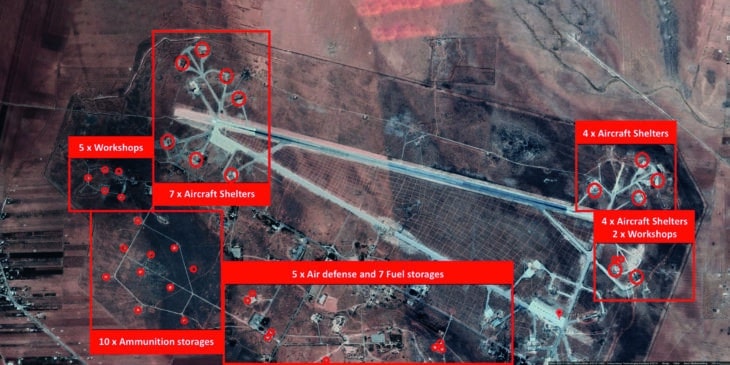A Primer on Extended Deterrence
In July 2018, Fox News host Tucker Carlson asked U.S. President Donald J. Trump the following question: “Why should my son go to Montenegro to defend it from attack?”1

This question, which referred to NATO’s collective defense clause and what it potentially requires from the United States, encapsulates a key challenge of extended deterrence. While Montenegrins would have no difficulty understanding why their sons should defend their country, explaining why others should feel committed to do so for Montenegro—or any other member of the alliance—should it find itself under attack can prove more difficult. Yet, to deter such an attack in the first place, Montenegro likely needs to convince a potential aggressor that the United States is ready to send its sons to war for its sake.
This article offers a primer on the notion of extended deterrence. It reviews the characteristics of extended deterrence and the triangular relationship that underlies it; examines the credibility issue at the core of extended deterrence; and, finally, offers suggestions for states to improve the credibility of the extended deterrence posture on which they rely.
Small states with large neighbors
Extended deterrence refers to a situation where one state (traditionally called the “defender”) warns another state (“potential attacker”) that it will defend its ally (the “protégé”) by force if necessary.2 This is, effectively, a case of deterrence being extended to an ally. Just as for direct deterrence, there are cases of extended-immediate deterrence, when the state to be defended is facing an immediate threat; and cases of extended-general deterrence, which describe a steady-state relation between three countries with a potential threat looming in the background, but no immediate cause for concern3.
Extended deterrence can be a form of deterrence by punishment: by committing to come to an ally’s help if it is attacked, the defender promises retaliation. This retaliation can take many forms, theoretically up to the use of nuclear weapons4. Yet extended deterrence should first and foremost be deterrence by denial—as Schelling (1960) put it, “the purpose is deterrence ex ante, not revenge ex post.”5 The defender can do so by helping its allies bolster their defenses—through stationing forces, military sales, technology transfers, training and joint exercises, or intelligence sharing, for instance—in order to make them less attractive targets.
Extended deterrence is generally credited for containing Soviet aggression during the Cold War,6 and Lawrence Freedman points that “It is notable that Russia has attacked non-allies Ukraine and Georgia rather than allies Estonia and Latvia.”7 Yet there have been some spectacular failures, such as the loss of Czechoslovakia to Nazi Germany in 1938-39 in spite of its formal military alliance with France; Poland in 1939; or the attack of South Korea by North Korea (with the support of China and the Soviet Union) in 1950 in spite of U.S. efforts to prevent such an attack.8
Extended deterrence is a particularly attractive form of deterrence for small states with large—and potentially aggressive—neighbors, because it compensates for the protégé’s lesser military capabilities in comparison with the potential attacker’s. However, a key downside of extended deterrence is that, in effect, very little of the decision to deter is left to the protégé, and much to the defender. As in “standard” deterrence, the credibility of extended deterrence lies in the defender’s level of military capabilities and its willingness to use them. However, both of these factors prove more problematic in the case of extended deterrence.9
Willingness to defend
First, the issue of measuring capabilities, and assessing whether they might deter a potential aggressor, becomes more complex. Should one focus on the local balance of forces, or all the forces that the defender could theoretically mobilize for the defender?
Also, what amount of capabilities can be credibly committed to the defense of an endangered ally, when the defender may have already other commitments going on elsewhere in the world (and needs to keep some capabilities to protect against a potential attack against its homeland)? The second issue—the defender’s willingness to use military force—is even more problematic. Thomas Schelling argues that “The difference between the national homeland and everything ‘abroad’ is the difference between threats that are inherently credible, even if unspoken, and threats that have to be made credible. To project the shadow of one’s military forces over other countries and territories is an act of diplomacy.”10 The defender and its ally may have different perceptions of what should be defended: for instance, the defender may be less willing to defend a territory controlled by the ally rather than the ally’s territory (an important question, for Norway, in the case of Svalbard).11 They may also have different views on what constitutes a threshold—for instance, what qualifies as a NATO’s Article 5 “attack.” Finally, the defender may have second thoughts on whether the commitment to defend is worth honoring at all.
Credible deterrence
What makes extended deterrence credible? One component is the strength of the alliance that support the extended deterrence posture, as it influences the likelihood that the defender will come to its ally’s defense as promised. There are different ways in which a defender can make its commitment more credible, including making commitments public, so that it is more difficult to back up without losing face; or by conducting shows of force—such as exercises—that make clear that the defender’s forces can operate with the protégé’s forces.12 Another way to make commitments more credible is to develop flexible responses, so that the defender has a credible repertoire of responses to assist the protégé outside of a (unlikely, thus not credible) nuclear response.13
Scholars disagree on whether a state’s reputation for upholding its commitments represents a second component of credible deterrence. The “reputation argument” played a role in keeping the United States involved militarily in Vietnam as long as it did—according to the argument that, if the United States abandoned Vietnam, then the United States would be perceived as weak and lose the rest of Asia to communism14 —as well as in U.S. military involvement in several post-Cold War crises.15 Yet a number of studies have since concluded that a defender’s past actions represent a weak predictor of future ones and, accordingly, do not constitute a credible signal of resolve.16 Additionally, as Morgan (2003) notes, “Making all commitments of equal importance is a recipe for exhaustion in upholding lesser ones and thereby losing credibility on others.”17
Also under debate is a third component—the degree to which the deterrent message should be explicit, or leave some room to uncertainty. Schelling (1960) argues in favor of the former, noting that “Any loopholes the threatening party leaves himself, if they are visible to the threatened party, weaken the visible commitment and hence reduce the credibility of the threat.”18 Morgan (2003), however, notes that even when decision-makers tried to signal a clear commitment, “clarifying commitments and expectations was never complete, because rarely in politics is it appropriate to say something exactly and leave no room for later adjustments. There is also an inhibiting element in ambiguity which can be exploited to achieve deterrence. Debate continues as to whether an element of ambiguity about commitments and prospective responses to an attack enhances or detracts from deterrence.”19 A third option is a mixed message, with different degrees of precision on what is to be deterred and what will be the punishment if the attacker ignores the deterrent threat. Being precise on the former and vague on the latter potentially brings the benefits of both a precise threat and room for maneuver to respond. One illustration is the debate around U.S. President Barack Obama’s 2013 so-called “red line” on chemical weapons attacks against civilians by the Syrian regime of Bashar al-Assad, where the threat of use of force may have succeeded in getting Assad to engage in a voluntary process to get rid of these weapons,20 although whether that process was a success in the end remains questionable.21
This question, which referred to NATO’s collective defense clause and what it potentially requires from the United States, encapsulates a key challenge of extended deterrence. While Montenegrins would have no difficulty understanding why their sons should defend their country, explaining why others should feel committed to do so for Montenegro—or any other member of the alliance—should it find itself under attack can prove more difficult. Yet, to deter such an attack in the first place, Montenegro likely needs to convince a potential aggressor that the United States is ready to send its sons to war for its sake.
This article offers a primer on the notion of extended deterrence. It reviews the characteristics of extended deterrence and the triangular relationship that underlies it; examines the credibility issue at the core of extended deterrence; and, finally, offers suggestions for states to improve the credibility of the extended deterrence posture on which they rely.
Small states with large neighbors
Extended deterrence refers to a situation where one state (traditionally called the “defender”) warns another state (“potential attacker”) that it will defend its ally (the “protégé”) by force if necessary.2 This is, effectively, a case of deterrence being extended to an ally. Just as for direct deterrence, there are cases of extended-immediate deterrence, when the state to be defended is facing an immediate threat; and cases of extended-general deterrence, which describe a steady-state relation between three countries with a potential threat looming in the background, but no immediate cause for concern3.
Extended deterrence can be a form of deterrence by punishment: by committing to come to an ally’s help if it is attacked, the defender promises retaliation. This retaliation can take many forms, theoretically up to the use of nuclear weapons4. Yet extended deterrence should first and foremost be deterrence by denial—as Schelling (1960) put it, “the purpose is deterrence ex ante, not revenge ex post.”5 The defender can do so by helping its allies bolster their defenses—through stationing forces, military sales, technology transfers, training and joint exercises, or intelligence sharing, for instance—in order to make them less attractive targets.
Extended deterrence is generally credited for containing Soviet aggression during the Cold War,6 and Lawrence Freedman points that “It is notable that Russia has attacked non-allies Ukraine and Georgia rather than allies Estonia and Latvia.”7 Yet there have been some spectacular failures, such as the loss of Czechoslovakia to Nazi Germany in 1938-39 in spite of its formal military alliance with France; Poland in 1939; or the attack of South Korea by North Korea (with the support of China and the Soviet Union) in 1950 in spite of U.S. efforts to prevent such an attack.8
Extended deterrence is a particularly attractive form of deterrence for small states with large—and potentially aggressive—neighbors, because it compensates for the protégé’s lesser military capabilities in comparison with the potential attacker’s. However, a key downside of extended deterrence is that, in effect, very little of the decision to deter is left to the protégé, and much to the defender. As in “standard” deterrence, the credibility of extended deterrence lies in the defender’s level of military capabilities and its willingness to use them. However, both of these factors prove more problematic in the case of extended deterrence.9
Willingness to defend
First, the issue of measuring capabilities, and assessing whether they might deter a potential aggressor, becomes more complex. Should one focus on the local balance of forces, or all the forces that the defender could theoretically mobilize for the defender?
Also, what amount of capabilities can be credibly committed to the defense of an endangered ally, when the defender may have already other commitments going on elsewhere in the world (and needs to keep some capabilities to protect against a potential attack against its homeland)? The second issue—the defender’s willingness to use military force—is even more problematic. Thomas Schelling argues that “The difference between the national homeland and everything ‘abroad’ is the difference between threats that are inherently credible, even if unspoken, and threats that have to be made credible. To project the shadow of one’s military forces over other countries and territories is an act of diplomacy.”10 The defender and its ally may have different perceptions of what should be defended: for instance, the defender may be less willing to defend a territory controlled by the ally rather than the ally’s territory (an important question, for Norway, in the case of Svalbard).11 They may also have different views on what constitutes a threshold—for instance, what qualifies as a NATO’s Article 5 “attack.” Finally, the defender may have second thoughts on whether the commitment to defend is worth honoring at all.
Credible deterrence
What makes extended deterrence credible? One component is the strength of the alliance that support the extended deterrence posture, as it influences the likelihood that the defender will come to its ally’s defense as promised. There are different ways in which a defender can make its commitment more credible, including making commitments public, so that it is more difficult to back up without losing face; or by conducting shows of force—such as exercises—that make clear that the defender’s forces can operate with the protégé’s forces.12 Another way to make commitments more credible is to develop flexible responses, so that the defender has a credible repertoire of responses to assist the protégé outside of a (unlikely, thus not credible) nuclear response.13
Scholars disagree on whether a state’s reputation for upholding its commitments represents a second component of credible deterrence. The “reputation argument” played a role in keeping the United States involved militarily in Vietnam as long as it did—according to the argument that, if the United States abandoned Vietnam, then the United States would be perceived as weak and lose the rest of Asia to communism14 —as well as in U.S. military involvement in several post-Cold War crises.15 Yet a number of studies have since concluded that a defender’s past actions represent a weak predictor of future ones and, accordingly, do not constitute a credible signal of resolve.16 Additionally, as Morgan (2003) notes, “Making all commitments of equal importance is a recipe for exhaustion in upholding lesser ones and thereby losing credibility on others.”17
Also under debate is a third component—the degree to which the deterrent message should be explicit, or leave some room to uncertainty. Schelling (1960) argues in favor of the former, noting that “Any loopholes the threatening party leaves himself, if they are visible to the threatened party, weaken the visible commitment and hence reduce the credibility of the threat.”18 Morgan (2003), however, notes that even when decision-makers tried to signal a clear commitment, “clarifying commitments and expectations was never complete, because rarely in politics is it appropriate to say something exactly and leave no room for later adjustments. There is also an inhibiting element in ambiguity which can be exploited to achieve deterrence. Debate continues as to whether an element of ambiguity about commitments and prospective responses to an attack enhances or detracts from deterrence.”19 A third option is a mixed message, with different degrees of precision on what is to be deterred and what will be the punishment if the attacker ignores the deterrent threat. Being precise on the former and vague on the latter potentially brings the benefits of both a precise threat and room for maneuver to respond. One illustration is the debate around U.S. President Barack Obama’s 2013 so-called “red line” on chemical weapons attacks against civilians by the Syrian regime of Bashar al-Assad, where the threat of use of force may have succeeded in getting Assad to engage in a voluntary process to get rid of these weapons,20 although whether that process was a success in the end remains questionable.21
…a need for the protégé to prove by whichever way that it is not “free-riding” on the defender but is paying its dues. In that perspective, the currency in which these dues are paid matters
No «free-riding»
Against this background, the protégé has a few options to strengthen extended deterrence. First, it can signal to the potential attacker that the defender is ready to come to its defense. Making such defense as automatic as possible is in the interest of the protégé, for it reduces the space for political decision on the part of the defender. Schelling (1960) described as critical to deterrence in general “to leave as little room as possible for judgement or discretion in carrying out the threat.”22 Formal treaties can achieve—to some extent—that purpose, as do positioning forces acting as tripwires on the territory of the protégé, or the hosting of weapons systems that make the protégé a key element of the defender’s broader defense posture.
A second option for the protégé to strengthen extended deterrence is to signal to the defender that it is a “good ally” that not only deserves to be defended, but whose defense is in the interest of the defender. The hosting of forces and weapons system already mentioned can contribute to filling that purpose, as do other types of “niche” capabilities that the protégé can offer—for instance, the “eyes on the ground” provided by local sources of intelligence. More broadly, this points to a need for the protégé to prove by whichever way that it is not “free-riding” on the defender but is paying its dues. In that perspective, the currency in which these dues are paid matters, and whether one is better off paying in treasure—for instance, 2 percent of GDP in defense spending—or in blood—for instance, through a high participation in “U.S.-led expeditionary operations without complaint or caveats”23 depends on the preferences of the defender, as well as on the domestic constraints of the protégé.
Conclusion
To conclude, it is worth noting that while the strength of alliances fluctuates, a protégé is not necessarily in danger of being attacked when the relationship is in a “down” phase as long as the potential attacker believes that there is still a good enough chance the defender will defend and the defender can threaten a level of retaliation that the potential attacker is not ready to accept. Yet this positive note should be nuanced, for it posits that the potential attacker is rational. In practice, the potential attacker may still attack even when the protégé believes it can rely on credible deterrence. Maybe the attacker is willing to take high risks, particularly if it is in a situation where it needs to recoup losses.24 Another risk is an asymmetry of information whereby the potential attacker underestimates the chances that the defender will defend the protégé, and chooses to carry out an attack, for ultimately deterrence is only as strong as the potential attacker thinks it is.25




